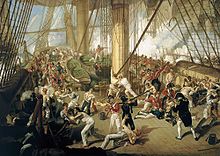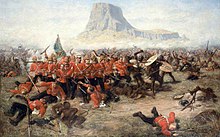
A | B | C | D | E | F | G | H | CH | I | J | K | L | M | N | O | P | Q | R | S | T | U | V | W | X | Y | Z | 0 | 1 | 2 | 3 | 4 | 5 | 6 | 7 | 8 | 9

A war artist is an artist either commissioned by a government or publication, or self-motivated, to document first-hand experience of war in any form of illustrative or depictive record.[1][2][3] War artists explore the visual and sensory dimensions of war, often absent in written histories or other accounts of warfare.[4]

These artists may be involved in war as onlookers to the scenes, military personnel, or as specifically commissioned to be present and record military activity.[5]
Artists record military activities in ways that cameras and the written word cannot. Their art collects and distills the experiences of the people who endured it.[6] The artists and their artwork affect how subsequent generations view military conflicts. For example, Australian war artists who grew up between the two world wars were influenced by the artwork which depicted the First World War, and there was a precedent and format for them to follow.[7]
Official war artists have been appointed by governments for information or propaganda purposes and to record events on the battlefield,[8] but there are many other types of war artists. These can include combatants who are artists and choose to record their experiences, non-combatants who are witnesses of war, and prisoners of war who may voluntarily record the conditions or be appointed war artists by senior officers.
In New Zealand, the title of appointed "war artist" is "army artist". In the United States, the term "combat artist" has come to be used to mean the same thing.[9][10]
Some examples and their background
- William Simpson was an artist-correspondent who sent artwork to London from the front during the Crimean War.[11]
- Alfred Waud was an American Civil War pictorial newspaper illustrator.
- Ogata Gekkō and Tsuguharu Foujita created woodblock prints for Japanese publications.
- Ronald Searle recorded life in Japanese POW camps.[12][13]
- Emmanuel Leutze's 1851 studio painting of Washington Crossing the Delaware is historically incorrect, and Leutze was born decades after the event his painting depicts, but this work has become an icon of popular culture.
War artists by nationality
It has been suggested that this section should be split into a new article titled War artists by nationality. (discuss) (September 2021) |
Argentine
- Cándido López (1840–1902), Paraguayan War
Australian

War artists have depicted all the conflicts in which Australians have been called to combat. The Australian tradition of "official war artists" started with the First World War. Artists were granted permission to accompany the Australian Imperial Force to record the activities of its soldiers. During the Second World War, the Australian War Museum, later called the Australian War Memorial, engaged artists. At the same time, the Royal Australian Navy, Australian Army, and Royal Australian Air Force appointed official war artist-soldiers from within their ranks.[14] These embedded war artists have depicted the activities of Australian forces in Korea, Vietnam, East Timor, Afghanistan, and Iraq.
The ranks of non-soldier artists like George Gittoes continue to create artwork which becomes a commentary on Australia's military actions in war.[15]
- Selected artists
A select list of representative Australian artists includes:
Austrian


British
British participation in foreign wars has been the subject of paintings and other works created by Britain's war artists. Artwork like the 1688 painting,The Fleet at Sea by Willem van de Velde the Younger depict the Royal Navy in readiness for battle. The Ministry of Defence art collection includes many paintings showing battle scenes, particularly naval battles.[32] Military art and portraiture has evolved along with other aspects of war. The British official war artists of the First World War created a unique account of that conflict. The British War Artists Scheme expanded the number of official artists and enlarged the scope of their activities during the Second War.[33]
Significant themes in the chronicle of twentieth-century wars have been developed by non-military, non-official, civilian artists. For example, society portraitist Arabella Dorman's paintings of wounded Iraq War veterans inspired her to spend two weeks with three regiments in different frontline areas: the Green Jackets at Basra Palace, the Queen's Own Gurkhas at Shaibah Logistics Base ten miles south-west of Basra, and the Queen's Royal Lancers in the Maysaan desert. In the field, Dorman drew quick charcoal portraits of the men she met. Returning to England, the sketches she made helped her use art to "evoke the emotions and psychological impact of war," rather than depicting the "physical horror" of war.[34]
- Selected artists
A select list of representative British artists includes:
